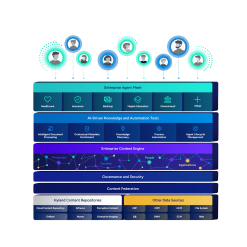Mass media and entertainment conglomerate
Media giant uses DAM to accelerate the production and approval of licensed products.

Harness the power of a unified content, process and application intelligence platform to unlock the value of enterprise content.
Learn more
Automate your document-centric processes with AI-powered document capture, separation, classification, extraction and enrichment.
Learn about Hyland IDPIt's your unique digital evolution … but you don't have to face it alone. We understand the landscape of your industry and the unique needs of the people you serve.
 Overview of industries
Overview of industries
Countless teams and departments have transformed the way they work in accounting, HR, legal and more with Hyland solutions.
 Overview of departments
Overview of departments
We are committed to helping you maximize your technology investment so you can best serve your customers.
 Overview of services
Overview of services

Learn proven strategies, connect with experts, innovate boldly
Register for CommunityLIVE 2026 today
Our exclusive partner programs combine our strengths with yours to create better experiences through content services.
Overview of partners
Join The Shift newsletter for the latest strategies and expert tips from industry leaders. Discover actionable steps to stay innovative.
Register now
Hyland connects your content and systems so you can forge stronger connections with the people who matter most.
Learn about HylandWith our modern, open and cloud-native platforms, you can build strong connections and keep evolving.
 Dig deeper
Dig deeper
Reading time minutes
Media giant uses DAM to accelerate the production and approval of licensed products.

A Nuxeo Platform customer in the media and entertainment industry realized that it needed to address the challenges of fast-moving changes in distribution channels and increasing customer demands for merchandise. The key was in developing an efficient approach to leveraging their vast catalog of intellectual property assets.
The multinational mass media and entertainment conglomerate partners with thousands of best-in-class licensees globally on award-winning ranges of toys, fashion, home décor and publishing inspired by high-profile franchises and properties. The company’s vast library consists of more than 61,000 hours of programming, including nearly 6,500 feature films and 3,000 television programs comprising tens of thousands of individual episodes. With innovative global licensing and merchandising programs, retail initiatives, promotional partnerships and themed experiences, it is also one of the leading licensing and retail merchandising organizations in the world.
Licensing intellectual property can be a major contributor to an enterprise’s revenue stream, with the company mentioned in this customer story generating over $6 billion in retails sales from merchandising, with an aggressive plan for new initiatives coming online to grow that number even further.
As part of those initiatives, the demand for digital content on a global scale continues to grow, as new digital content distribution models are emerging and constantly changing, and companies, especially ones in fast-moving sectors such as the entertainment industry, must be able to meet these needs. External retail partners are requiring such companies to provide ways for their platforms to integrate with the original license holder’s systems to retrieve any relevant metadata and artwork.
As a consequence, many intellectual-property-driven companies are looking to develop next-generation digital asset management and distribution platforms with developer-friendly, ultrareliable and highly secure set of services hosted in the cloud.
The same licensing and retail merchandising company recognized the requirement to enable the capture of creative assets for use on license content for consumer products. After a review of the existing process, they defined the need to create a brand library for external licensees to access the assets that they have licensed. For example, only giving manufacturers access to see digital assets related to a particular version of a movie character because they have a contract to make toys featuring that character.
To meet the customer’s requirements, we worked with them to develop two solutions based on the Nuxeo Platform.
For the Consumer Products licensing requirement, the solution was to deploy the Nuxeo Platform in the cloud as a digital asset management (DAM) system in order to search across 350,000 assets for, harvest, and license digital assets from the creative process.
The creative approval process to request new marketing assets starts in Nuxeo Platform managed by two DAM librarians. Once submitted and approved, integration with a work and project management tool generates a new creative project managed via integration with the existing Workfront tool, that was open to up to 2500 users across the licensor network. Once that project is completed, the final brand materials are sent back to Nuxeo Platform through its REST API, linked to the original request, enriched with corporate master data and licensing information, and published downstream for distribution.
In line with the client’s wish for a developer-friendly environment, Nuxeo’s low-code API-first driven approach meant that the solution was built by a team of just five developers in the space of just a few weeks.
The wider requirement of leveraging the company’s archive of legacy material resulted in the development of a content management and distribution platform that initially provided access for 1,000 users across the enterprise to around 20 million currently known assets. It is expected that this number could grow to 1 billion overall as enterprise-wide adoption continues.
The choice to develop these solutions on the Nuxeo Platform was driven by a combination of factors that fell broadly into the following areas:
The new Nuxeo Platform–based DAM platform makes it extremely easy for the company’s retail partners to find assets, download assets quickly and with multiple options, while at the same time making curating 350,000 assets painless for the company’s staff of digital librarians.
The goal of the new platform is to simplify content management and distribution and, as a result, accelerate the production, and approval of licensed products. New business opportunities require the company to deliver a large amount of content and metadata to their licensing partners in a short turnaround to meet movie release dates and associated product launches.
To remember: